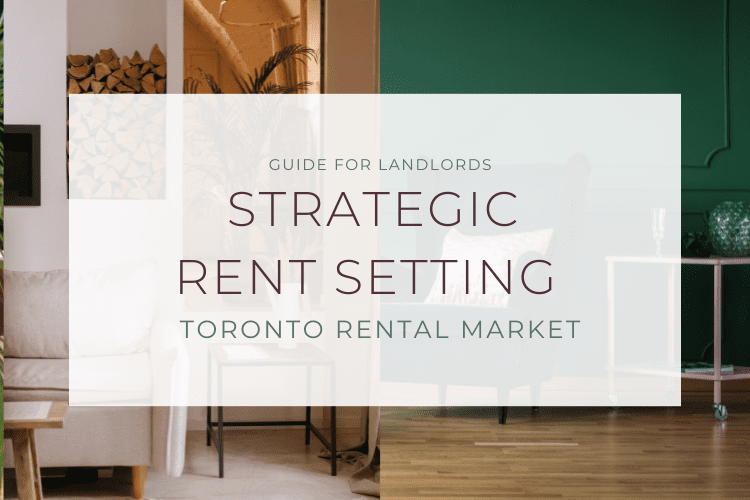The Toronto rental market in 2024 poses unique challenges and opportunities for landlords, shaped by an influx of new condo units, shifting economic conditions, and evolving tenant preferences. Our rent setting in Toronto guide delves deep into these dynamics, offering landlords actionable strategies for rent setting in this changing landscape.
Table of Contents
The State of the Market:
Recent trends in the Toronto rental market indicate a significant shift. Properties are staying on the market longer, signalling a move toward a buyer’s market. Tenants now enjoy a wider selection and less urgency in making rental decisions with no time crunch.
A crucial statistic from UrbanNation highlights this change: in 2023, there was a 30% increase in completed condo units compared to the previous year, leading to an oversupply in the market. This surge, combined with the traditionally slow fall season, exacerbated by rising rents and rates, outlines a complex scenario for landlords.
Understanding Rent Control in Toronto:
Understanding rent control is crucial for Toronto landlords. Properties first rented after November 15, 2018, fall outside the purview of rent control. This distinction affects your rent-setting strategies and tenant negotiations. It’s essential to stay updated with these regulations to ensure compliance and optimize your rental approach.
Do The Math: Covering Vacant Rent Vs. Renting For More Money:
One of the most crucial calculations for landlords involves evaluating the trade-off between renting for a higher price and the potential loss due to prolonged vacancy. This assessment is essential regardless of whether your property is currently tenanted, vacant, rent-controlled, or not.
Understanding the Risks of Overpricing:
If you increase rent too much, whether on a tenanted property or a vacant one, there’s a significant risk of not finding a tenant for an extended period. This can lead to substantial financial loss. For instance, if a property remains vacant for a month due to high rent, any extra income generated by eventually renting at a higher price must compensate for this lost month’s revenue.
Analyzing Market Dynamics:
Begin by examining the rental market dynamics in your property’s neighbourhood. Consider factors like:
- The current number of similar listings in the area.
- The average days on the market for these listings.
- The rate at which properties are being rented – what percentage of listings are rented out each week?
- The rent-to-price ratio in your area helps understand the return on investment.
A Real-Life Calculation Example:
Imagine you own a condo in a neighbourhood where similar units rent for $2,000 per month. You consider setting your rent at $2,200, hoping for higher returns. However, if this decision leads to your condo staying vacant for an extra month, you lose out on $2,000. To make this strategy worthwhile, the additional rent, in this case of $200 * 12 months = $2,400 should not only cover the lost month but also provide additional profit over a reasonable period.
Calculating Potential Loss and Gain:
If your condo stays vacant for one month, you lose $2,000. At the increased rent of $2,200, the extra $200 per month means it would take ten months just to recoup the lost rent from the vacant month. Any period beyond this starts to contribute to your profit.
Consideration of Inventory and Market Trends:
Compare the inventory in your area with the market trends. If there are many similar listings and properties are taking longer to rent, it’s a signal to be more conservative with rent increases. Conversely, if listings are scarce and properties are renting quickly, you might have more leeway with higher rent.
Seeking Professional Insights:
For landlords unsure about these calculations or the current market trends in their neighbourhood, consulting with a real estate professional can provide valuable insights. Our team of realtors can assist in analyzing these statistics and help you find the ideal balance for your rent-setting strategy.
If Competition Is High, You Must Be Priced Well:
In a competitive rental market, pricing your property effectively is more important than ever. To stand out, aim to price your unit within the top three lowest priced units for its category and area. This means closely monitoring market trends and adjusting your pricing strategy accordingly to remain competitive.
You Must Stand Out On The Market:
Attracting potential tenants goes beyond just pricing. In a market with high competition, your property needs to shine. This could mean investing in professional photography, and virtual staging, and ensuring that your unit is well-maintained and equipped with modern amenities. Items like window coverings, overhead lighting or a smart thermostat might seem irrelevant, but to a tenant with choices they could be the defining difference between your suite and one down the hall.
How To Get The Most Rent [Over The Entire Year]:
Maximizing annual rental income requires a nuanced strategy. We’ll explore different scenarios based on whether your property is rent-controlled or not, and how to balance immediate rental income against long-term financial gains.
How To Set Rent – Rent Controlled:
For rent-controlled properties, it’s important to resist the temptation to lower rents during slow periods. Instead, consider offering one-time incentives to attract tenants. This strategy helps keep your rental income stable without locking you into a lower rent for the long term.
How To Set Rent – NOT Rent Controlled:
For landlords managing non-rent controlled new builds, the current market poses a unique set of challenges, particularly due to fluctuating interest rates and high competition. Here’s a straightforward strategy to navigate this scenario:
- Keep Initial Rents Low: In a market saturated with new builds, like the recent situation at Peter & Adelaide Condos where over 100 rentals were listed in a single month, it’s crucial to keep your initial rents competitively low. This approach is particularly pertinent if you’ve just taken possession of a unit in a new building along with numerous other landlords. The high number of listings creates an environment where attracting tenants quickly becomes paramount to avoid prolonged vacancies.
- Mitigating the Risks of High Competition: By setting a lower initial rent, you significantly increase the likelihood of securing tenants in a shorter timeframe. This strategy helps mitigate the financial risks associated with long-term vacancies, which can often outweigh the benefits of setting a higher rent.
- Leveraging the Flexibility of Non-Rent Controlled Properties: One of the advantages of non-rent controlled properties is the flexibility in adjusting rents over time. Given that your property is not subject to rent control, you have the option to reassess and increase rents later, ideally one or two years down the line. This approach allows you to adapt to market changes and potentially increase your rental income once the initial high competition phase has subsided.
- Practical Example: Consider a scenario where your newly built condo could be listed for $2,200 per month based on market rates. However, given the high competition, setting the rent at a slightly lower rate, say $2,000, could make your property more attractive to potential tenants. Once the market stabilizes and competition decreases, you can consider incrementally increasing the rent, aligning with market rates and the value your property offers.
- Conclusion: In sum, the key to success for non-rent controlled new builds in a competitive market is to start with lower initial rents to attract tenants quickly and reduce vacancy risks. As the market evolves and your property stands out, you’ll be in a position to adjust the rents accordingly, optimizing your rental income in the long term.
How To Set Rent – Tenanted Property:
In both rent-controlled and non-rent-controlled scenarios, landlords should contemplate the advantages of moderate rent increases. This approach can enhance tenant loyalty and reduce turnover, which is particularly important in a market experiencing a slowdown.
Conclusion:
In 2023, the Toronto rental market requires landlords to adopt a strategic, informed approach. Understanding market trends, legal frameworks, and tenant preferences is key to navigating these challenging times. This guide equips landlords with the necessary knowledge and strategies for effective rent setting, ensuring a profitable and sustainable rental business in the dynamic Toronto market.
Stay updated with the latest in real estate by subscribing to my blog. For more insights and tips, follow me on TikTok and Instagram.


Pierre Carapetian
Pierre Carapetian is the Broker Of Record for Pierre Carapetian Group Realty with over 12 years of experience in the real estate market. As a proud Torontonian and real estate broker, he prides himself on knowing this city inside out. He started investing at the age of 18 and has facilitated over half a billion dollars in real estate transactions.
Frequently Asked Questions:
How do I know if my property is rent-controlled?
In Toronto, rent control regulations apply differently based on when a property was first rented out. Properties that were rented for the first time after November 15, 2018, are not subject to rent control. This means that for these newer properties, landlords have more flexibility in setting and adjusting rent prices without being bound by the annual rent increase guidelines set by the government. This distinction is crucial for landlords to understand, as it significantly impacts how they can manage rent prices and negotiate with tenants.
How is the 2024 Toronto Rental Market Affecting Landlords?
The 2024 Toronto rental market is marked by an increase in new condo units and changing tenant preferences, leading to longer property vacancies and a shift towards a buyer’s market. These changes require landlords to adopt more strategic rent-setting approaches.
How Does the 30% Increase in Condo Units Impact the Toronto Rental Market?
The 30% increase in completed condo units in 2023 has led to an oversupply in the market, exacerbating the traditionally slow fall season and creating a highly competitive environment for landlords.
How Should Landlords Approach Rent Setting for Non-Rent Controlled Properties?
Landlords of non-rent controlled properties, especially in new builds with high competition, should initially set lower rents to attract tenants quickly and can reassess rents later as these properties are not subject to rent control.
What Are the Risks of Overpricing Rental Properties?
Overpricing, whether for tenanted or vacant properties, can lead to prolonged vacancies and substantial financial loss, as any additional income from higher rents must compensate for periods when the property is unoccupied.
How Can Landlords Effectively Stand Out in a Competitive Rental Market?
To stand out in a competitive market, landlords should price their properties within the top three for affordability in their category and invest in enhancing their property’s appeal through professional presentation and modern amenities.


